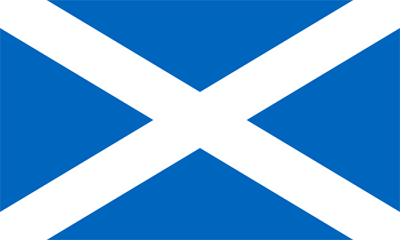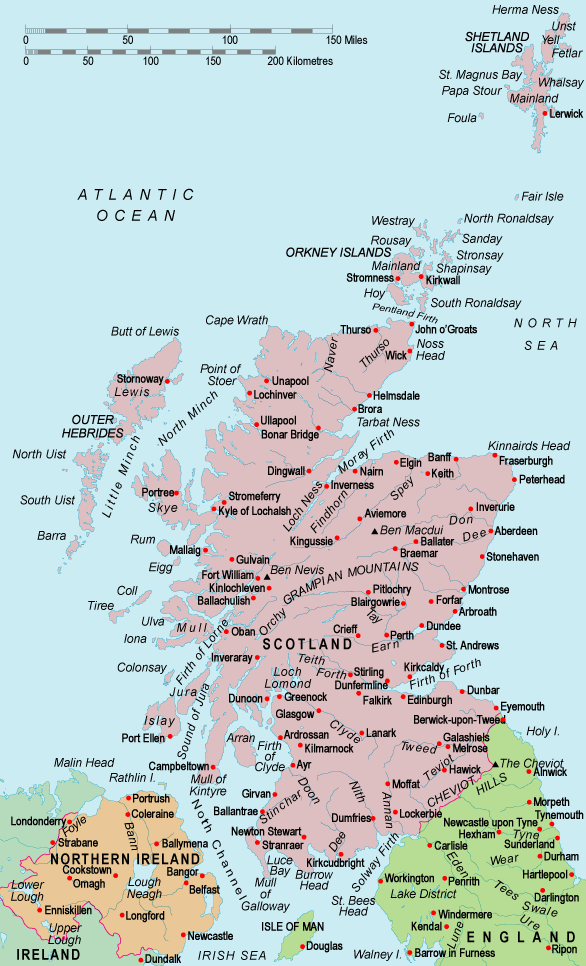Scotland (Alba)

More than 5.3 million people call Scotland home. Fully 87,000 Scots claim some skill in the gioedlic Celtic language of Scots Gaelic. That’s more than 16% of population. Scotland lays claim to the highland pipes and the dance traditions of the Strathspey. Musicologists report that Scotland was where the jig originated.
The population of Scotland is roughly the same size as the population of Minnesota. The land area of Scotland is about the same size as South Carolina.
A significant, and beautiful, component of Scottish music comes from the fiddle traditions of the Shetland Island. These island lie along the seam between the Atlantic Ocean and the North Sea. Shetland is about fify miles north of the Orkney Island and a bit more than 100 miles north of the Scottish mainland. Shetland has historically been a convenient stopover point between Scandinavia and the British Isles (think Vikings). So the music of Shetland has had many influences and that makes it complex compelling and unique.
The population of Scotland is roughly the same size as the population of Minnesota. The land area of Scotland is about the same size as South Carolina.
A significant, and beautiful, component of Scottish music comes from the fiddle traditions of the Shetland Island. These island lie along the seam between the Atlantic Ocean and the North Sea. Shetland is about fify miles north of the Orkney Island and a bit more than 100 miles north of the Scottish mainland. Shetland has historically been a convenient stopover point between Scandinavia and the British Isles (think Vikings). So the music of Shetland has had many influences and that makes it complex compelling and unique.

The traditional fiddle music of Scotland roughly divides into four styles.
1. Polkas of the Northern islands
2. Reels and jigs of the Highlands
3. Strathspeys and airs of the northeast
4. Airs and hornphipes of the border region
Of course, all forms are found in all regions. However, each region tends to have a unique contribution to the traditional forms of Scottish music.
The strathspey is instantly discernible in traditional Celtic music. "Strath" is a Scottish word for a wide river valley. "Spey" is a river in northeast Scotland. The river Spey is a major area for salmon fishing and production of Scotch whisky. Strathspey is the region around the river.
A strathspey is a type of reel. The 4|4 time meter is punctuated by the “Scottish Snap”. This technique is an exaggerated style of playing a 16th note before a dotted 8th note. This notation “snaps” the melody. The technique can be a bit jerky, but without doubt the technique produces a lot of rhythmic tension and energy. Think of the tune of Coming Through the Rye. and sing it in staccato. That’s the essence of the Scottish snap and what underlies the playing style of a strathspey.
A typical tempo for a strathspey is a bit slower than that of a reel. Something around 105 to 110 bpm would do for a strathspey. A step dance might be up to 160 bpm.
The Scottish snap is also a unique contribution to traditional music. Scotland has a tradition of "mouth music" called puirt-a-beul. This song form requires lyrics to be sung very rapidly. In Scots Gaelic the first syllable of a word is emphasized. This quick emphasis lead to the fiddle mimicking the voice. The result is the "Scottish snap".
Scotland “owns” the bagpipe. At least it has a strong claim on the highland form of the pipes. It is that form that most people recognize as the true bagpipes. The ubiquity of the great highland bagpipe is likely due to the vast reach of the British Empire during the 19th century. The English military embraced the pipes as a means to inspire troops and put fear into enemies. Those soldiers were stationed around the world. North America, India, Pakistan, Australia. And the pipes were in those places too.
Scholars believe that the bagpipe was an invention of ancient Egypt. As Greek and Roman cultures clashed with Egyptian culture the pipes were brought to Europe. There are coins from ancient Rome depicting the Emperor Nero playing the bagpipes. Perhaps Nero actually pipping while Rome burned. For more information on the history of bagpipes visit Soctia Pipes.
http://www.scotiapipers.co.uk/about-scotia-pipers/bagpipe-history
The harp was at one time considered to be the national instrument of Scotland. Pictish carvings dating to the 9th centure show the harp being played. The Welsh cleric Girladus Cmbrensis' (Gerald of Wales) account of his 1188 travels throughout the British Isles describes the wire-strung harp tradition of Scotland surpassed the quality of harp playing in Ireland. It is also fair to say that Girladus Cmbrensis wrote little that was favorable toward the Irish.
Two important traditional Scottish musicians to note are Neil Gow and Robert Burns. Neil Gow was a composer and violinist, His sons created a publishing house that printing a great volume of traditional music. Robert Burns played the fiddle, and was an avid collector of traditional tunes. He set much of his poetry to the music of Scotland. The melody of Auld Lang Synge is a traditional Scottish tune.
1. Polkas of the Northern islands
2. Reels and jigs of the Highlands
3. Strathspeys and airs of the northeast
4. Airs and hornphipes of the border region
Of course, all forms are found in all regions. However, each region tends to have a unique contribution to the traditional forms of Scottish music.
The strathspey is instantly discernible in traditional Celtic music. "Strath" is a Scottish word for a wide river valley. "Spey" is a river in northeast Scotland. The river Spey is a major area for salmon fishing and production of Scotch whisky. Strathspey is the region around the river.
A strathspey is a type of reel. The 4|4 time meter is punctuated by the “Scottish Snap”. This technique is an exaggerated style of playing a 16th note before a dotted 8th note. This notation “snaps” the melody. The technique can be a bit jerky, but without doubt the technique produces a lot of rhythmic tension and energy. Think of the tune of Coming Through the Rye. and sing it in staccato. That’s the essence of the Scottish snap and what underlies the playing style of a strathspey.
A typical tempo for a strathspey is a bit slower than that of a reel. Something around 105 to 110 bpm would do for a strathspey. A step dance might be up to 160 bpm.
The Scottish snap is also a unique contribution to traditional music. Scotland has a tradition of "mouth music" called puirt-a-beul. This song form requires lyrics to be sung very rapidly. In Scots Gaelic the first syllable of a word is emphasized. This quick emphasis lead to the fiddle mimicking the voice. The result is the "Scottish snap".
Scotland “owns” the bagpipe. At least it has a strong claim on the highland form of the pipes. It is that form that most people recognize as the true bagpipes. The ubiquity of the great highland bagpipe is likely due to the vast reach of the British Empire during the 19th century. The English military embraced the pipes as a means to inspire troops and put fear into enemies. Those soldiers were stationed around the world. North America, India, Pakistan, Australia. And the pipes were in those places too.
Scholars believe that the bagpipe was an invention of ancient Egypt. As Greek and Roman cultures clashed with Egyptian culture the pipes were brought to Europe. There are coins from ancient Rome depicting the Emperor Nero playing the bagpipes. Perhaps Nero actually pipping while Rome burned. For more information on the history of bagpipes visit Soctia Pipes.
http://www.scotiapipers.co.uk/about-scotia-pipers/bagpipe-history
The harp was at one time considered to be the national instrument of Scotland. Pictish carvings dating to the 9th centure show the harp being played. The Welsh cleric Girladus Cmbrensis' (Gerald of Wales) account of his 1188 travels throughout the British Isles describes the wire-strung harp tradition of Scotland surpassed the quality of harp playing in Ireland. It is also fair to say that Girladus Cmbrensis wrote little that was favorable toward the Irish.
Two important traditional Scottish musicians to note are Neil Gow and Robert Burns. Neil Gow was a composer and violinist, His sons created a publishing house that printing a great volume of traditional music. Robert Burns played the fiddle, and was an avid collector of traditional tunes. He set much of his poetry to the music of Scotland. The melody of Auld Lang Synge is a traditional Scottish tune.
The music of Scotland’s northern archipelagos of Orkney and Shetland, deserve special note. Until the early nineteenth century a Western Scandinavian language was spoken in both the Orkney and Shetland Islands. Vikings arrived on the Islands in the ninth century and ruled the Islands until the fifteenth century when both archipelagos came under Scottish rule. The music of the Islands is a mixture of Scottish and Scandinavian forms. Many family names in the Orkney Islands are Scandinavian, not Scottish. Shetlanders are neither completely Scottish nor Scandinavian. Fiddling styles of Shetland have more in common with bowing styles of Scandinavia than those of mainland Scotland.
A key person in the musical history of the Shetland Island was Tom Anderson (1910-1991) He is widely credited with saving and reviving the fiddle tradition of the Shetland Islands. His original compositions are a core of the contemporary fiddle repertoire of Shetland.
A key person in the musical history of the Shetland Island was Tom Anderson (1910-1991) He is widely credited with saving and reviving the fiddle tradition of the Shetland Islands. His original compositions are a core of the contemporary fiddle repertoire of Shetland.
The Scottish tunes below are presented in both standard notation and ABC notation. Click on the audio players to hear the tunes. If you want to download an mp3 file of a tune to study it in greater depth, go to the tune download page.
Performance examples of Scottish music are available at this link.
Performance examples of Scottish music are available at this link.
Tunes For The Class
|
|
| ||||||||||||||||||||||||||||||||||||
More Scottish Tunes
|
| ||||||||||||||||||||||||||||||||||||||||||||
|
|
| ||||||||||||||||||||||||||||||||||||
| boannie_isle_owhalsey_.pdf | |
| File Size: | 32 kb |
| File Type: | |